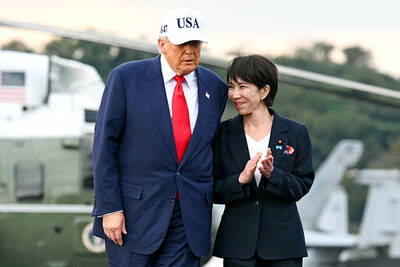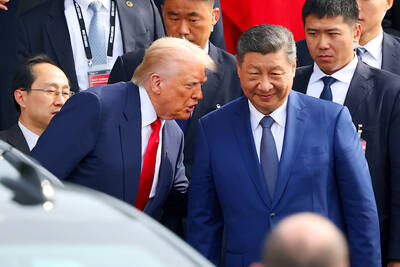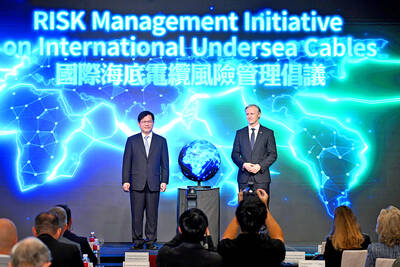The UN climate panel issued its strongest warning yet yesterday that human activities are heating the planet, adding pressure on governments to do more to combat accelerating global warming.
The International Panel on Climate Change, an authoritative group on warming of 2,500 scientists from more than 130 nations, predicted more severe rains, melting glaciers, heatwaves and rising sea levels, especially if Antarctica or Greenland thaw.
The final text said it was "very likely" -- or a probability of more than 90 percent -- that human activities led by burning fossil fuels explained most of the warming in the past 50 years.
That is a tougher stance than in the group's last report, in 2001, when the IPCC said the link was "likely," or 66 percent probable. Signs of change range from drought in Australia to record high temperatures in Europe last month.
"February 2, 2007, may be rem-embered as the day the question mark was removed from whether [people] are to blame for climate change," Achim Steiner, the head of the UN Environment Program, told a news conference.
He urged governments to inject more momentum into stalled talks on long-term cuts in emissions. Greenhouse gas levels in the atmosphere have not been higher in 650,000 years.
"We are in a sense doing things that have not happened in 650,000 years, based on the scientific evidence," Rajendra Pachauri, the head of the IPCC, told a news conference.
A senior US government scientist, Susan Solomon, said of the report's release, "There can be no question that the increase in greenhouse gases are dominated by human activities."
A 21-page summary of scientific findings for policy makers outlines wrenching changes such as a possible melting of Arctic sea ice in summers by 2100 and says it is "more likely than not" that greenhouse gases have made tropical cyclones more intense.
The report predicts a "best estimate" that temperatures would rise by between 1.8oC and 4oC in the 21st century, within a likely range from 1.1oC to 6.4oC.
Temperatures rose 0.7oC in the 20th century and the 10 hottest years since records began in the 1850s have occured since 1994.
UN officials hope the report will prompt governments -- led by the US, the top emitter -- and companies to do more to cut greenhouse gases, released mainly by burning fossil fuels in power plants, factories and cars.
Many backers of the UN's Kyoto Protocol, a plan binding 35 industrial nations to cut emissions of greenhouse gases by 2012, want outsiders to get more involved. The US and China are not bound by Kyoto targets.
The head of the US delegation said that President George W. Bush's policies, braking the rise of emissions rather than cutting them, were working.
"The President has put in place a comprehensive set of policies to address what he has called the `serious challenge' of climate change," said Sharon Hays, Associate Director of the White House Office of Science & Technology Policy.
Bush pulled out of Kyoto in 2001, saying caps would harm the economy. He focuses instead on big investments in technologies such as hydrogen and biofuels.
The President of Kiribati, a group of 33 Pacific coral atolls threatened by rising seas, said time was running out.
"The question is, what can we do now?" President Anote Tong said.
The report projects a rise in sea levels of between 18cm and 59cm in the 21st century -- and said that bigger gains could not be ruled out if ice sheets in Antarctica and Greenland thaw.
also see stories:
Scientists offered money to counter climate study

Japanese Prime Minister Sanae Takaichi yesterday lavished US President Donald Trump with praise and vows of a “golden age” of ties on his visit to Tokyo, before inking a deal with Washington aimed at securing critical minerals. Takaichi — Japan’s first female prime minister — pulled out all the stops for Trump in her opening test on the international stage and even announced that she would nominate him for a Nobel Peace Prize, the White House said. Trump has become increasingly focused on the Nobel since his return to power in January and claims to have ended several conflicts around the world,

UKRAINE, NVIDIA: The US leader said the subject of Russia’s war had come up ‘very strongly,’ while Jenson Huang was hoping that the conversation was good Chinese President Xi Jinping (習近平) and US President Donald Trump had differing takes following their meeting in Busan, South Korea, yesterday. Xi said that the two sides should complete follow-up work as soon as possible to deliver tangible results that would provide “peace of mind” to China, the US and the rest of the world, while Trump hailed the “great success” of the talks. The two discussed trade, including a deal to reduce tariffs slapped on China for its role in the fentanyl trade, as well as cooperation in ending the war in Ukraine, among other issues, but they did not mention

REASSURANCE: The US said Taiwan’s interests would not be harmed during the talk and that it remains steadfast in its support for the nation, the foreign minister said US President Donald Trump on Friday said he would bring up Taiwan with Chinese President Xi Jinping (習近平) during a meeting on the sidelines of the APEC Summit in South Korea this week. “I will be talking about Taiwan [with Xi],” Trump told reporters before he departed for his trip to Asia, adding that he had “a lot of respect for Taiwan.” “We have a lot to talk about with President Xi, and he has a lot to talk about with us. I think we’ll have a good meeting,” Trump said. Taiwan has long been a contentious issue between the US and China.

GLOBAL PROJECT: Underseas cables ‘are the nervous system of democratic connectivity,’ which is under stress, Member of the European Parliament Rihards Kols said The government yesterday launched an initiative to promote global cooperation on improved security of undersea cables, following reported disruptions of such cables near Taiwan and around the world. The Management Initiative on International Undersea Cables aims to “bring together stakeholders, align standards, promote best practices and turn shared concerns into beneficial cooperation,” Minister of Foreign Affairs Lin Chia-lung (林佳龍) said at a seminar in Taipei. The project would be known as “RISK,” an acronym for risk mitigation, information sharing, systemic reform and knowledge building, he said at the seminar, titled “Taiwan-Europe Subsea Cable Security Cooperation Forum.” Taiwan sits at a vital junction on